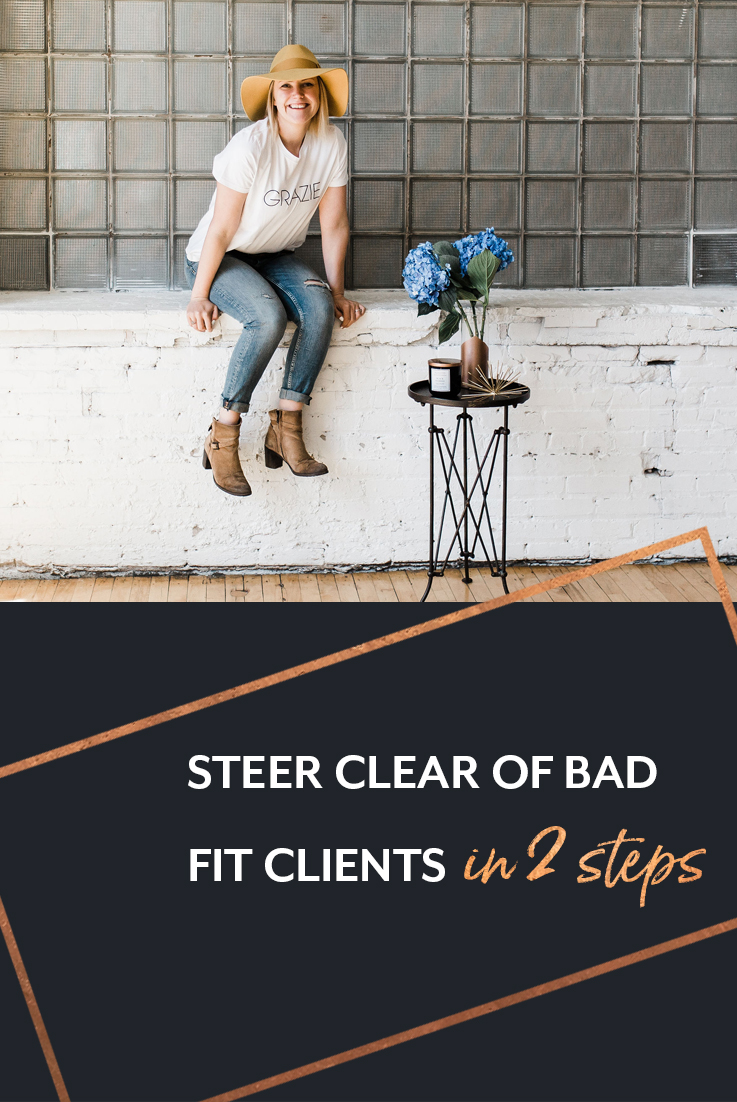Every entrepreneur I know has a “bad fit client story” … or two. 😉
… The web design customer who flew those red flags in the discovery call (but you booked it anyway), and then expected exactly 1,226 rounds of revisions. 😳
… The home buyer who wanted to look in the neighboring county you don’t serve, but didn’t want to be referred to your trusted colleague there. (You made exactly 1,227 trips there before she decided not to relocate after all.) 😳
… The client who wasn’t really in your preferred niche (but found you during a brief dry spell in your business – so you agreed.) You realized about a quarter of the way in that she was expecting exactly 1,228 steps that are not part of your normal process. 😳
Ugh. Just ugh.
To be fair, these aren’t bad people. (Okay, maybe occasionally one is. 👿 )
Mostly they’re just people who weren’t the right fit.
None of us want to work with these “bad fit” clients – the ones who don’t value your process, question your expertise, don’t respect your boundaries, and (worst part ➡️ ) detract from your ability to serve your other clients.
But how do you get to the point where the majority – or all – of your clients are those dreamy, perfect fit clients?
In this article, I’m reviewing the steps to take to make that a reality.
🎥 As per usual, if you prefer to watch and learn, the video version is below. If you like to read, then continue on…
First, a Word About Ideal Clients:
If you’ve ever been stumped or frustrated with an ideal client exercise in the past, you’re not the only one!
I’m not a big fan of the “Customer Avatar” worksheets… You know the ones! They instruct you to know for sure what your client likes, reads, thinks about… what she eats for breakfast on Thursdays, whether she likes a firm or soft pillow… what her prom’s theme song was…
(Okay I might be exaggerating, but I’ve seen some crazy avatar questions!)
To me, these exercises just aren’t based in reality. It feels like you’re guessing.
Because you are!
I’m here to help you start making more educated guesses based on what you believe now.
The best news? You don’t need to know your ideal client’s pillow preference. 😉
Step 1: Create your ideal client wish list.
The truth is, your ideal client will evolve over time. It’s actually really important to work with a variety of clients – at first. You need to experience firsthand what works and what doesn’t. You learn what kind of client you ultimately want to work with… (And who you don’t. But we’ll get to that…)
Remember when you were dating? (Or maybe you are now!) You were looking for the love of your life, so you wrote out a list of the attributes your perfect partner would have. #listsarefun
Then, you actually got out into the dating world. Upon interacting with real, live humans, you likely found that no one person ticked every single checkbox. But, some ticked more than others – and that meant they had potential.
Creating your ideal client avatar before you’ve worked with a bunch of clients is just like this dating scenario. You’re imagining the person who will value your work, recognize your talents, and jive well with your personality. You’re guessing what she or he would be like.
At first, you’ll probably find that most of your clients don’t embody every single one of those attributes. But you’ll gather a lot of valuable data through working with them. So think of it as an elimination process. As you work with more and more clients, it will be more and more clear who’s a fit – and who isn’t.
Now, on to Step 2…
Pin this article to reference later! 📌

Pin this article to reference later! 📌
Step 2: Decide who you don’t want to work with – and repel them.
Once you have a sense of who you’re looking for, and you’ve have some client work under your belt, step two is to decide who you don’t want to work with – and repel them.
Really the only way to learn this is “the hard way.”
Yes, I’m talking about working with some pain in the butt clients – those that grate on you, that just don’t share your values, that aren’t comfortable delegating… whatever those deal breakers are for you.
While this is not the most pleasant way to learn, it is often the best – and only – path to real, true clarity around this. Take solace in the fact that you are refining this process and your list – and it will be worth it!
Essentially, you are discovering who you ultimately want to work with – by learning who you want to avoid.
To help you with this, here are a few strategies and tactics to use as you refine.
Do this exercise – on the regular.
Start here. Answer these questions in depth to help define the specifics about this person that you don’t want to work with. (Remember, this is an iterative process, so revisit these questions from time to time and document your newest insights.)
What stage in their business are they in?
What do they believe that isn’t congruent with your beliefs?
What type of involvement do they demand from you as a product or service provider?
Who doesn’t place value on – or have the ability to pay what you charge – for your product or service?
Who are people that would violate any nonnegotiables of yours? Whose work would require that you go against a core value or belief that you hold?
To help illustrate this, I’m going to review with you what I’ve learned about my client deal breakers. For me, when I’m interviewing somebody as a possible client for my Clarity Code process – through which I help more advanced entrepreneurs scale their brands – these are some of the red flags that I look for.
If somebody doesn’t have any evidence of results, I don’t want to work with them via the Clarity Code program.
I do my best work when I’m maximizing what’s already effective and excellent about a person or about a company. So I’m looking for somebody who already has a foundation. He or she has a track record of success – and now want to reach and impact more people.
(Note: My Brand New Brand program is often a great choice for earlier-stage entrepreneurs.)
I don’t like working with people who aren’t invested in their brand.
I’ve discovered that some people are serial entrepreneurs – people who start a whole portfolio of businesses all at once. If someone is not particularly tied to one business or the other (It’s almost like she’s gambling!), she’s not a fit.
I would much rather work with an entrepreneur who is all in with her business – the one I’ll be supporting her with. This isn’t to say that they my ideal client can’t be multi-passionate. But I want to work with somebody who is going to see things through – and will do the hands-on work it takes to make a brand a success.
I don’t work with clients who only want design.
Talented designers are so, so important to a brand! But, you can’t skip the foundational steps in branding – the deep work of uncovering your core ideas, commitments, character – and more. If you jump past these fundamentals, you simply cannot maximize the results you’ll get from design and designers. So if somebody just wants to skip to the end (just skip to the pretty stuff!), he is not the client for me.
I don’t want to work with anybody who isn’t willing to delegate.
My process is set up to help people delegate pieces of their brands effectively. This is one of the main results our work produces.
So it doesn’t make sense for me to work with a client who doesn’t see value in that. Maybe the reason is a mindset problem, thinking she can’t afford a team, or simply a business model that doesn’t include delegating. Regardless, if she’s holding on to her brand with a death grip, my process isn’t going to be best-suited for her.
(Note that it took me some time – years, really – to be able to articulate these deal breakers, so don’t worry if you’re not sure yet. Stay in action, and you will gain the clarity you seek.)
Create a signature framework that’s custom-built for your ideal client.
Another way to disqualify or to avoid working with problem clients is to create a signature framework that is built specifically for your ideal client.
Here’s an example:
Before you know who you do – and don’t – want to work with, maybe you offer “social media management” services. But, once you are clear on your ideal client, you now offer:
“The Social Media Maverick Framework – An Effective Method to Boost Engagement, Traffic, and Sales – for rule-breaking entrepreneurs who don’t do cookie-cutter.”
Every goal, strategy, element, and step of your signature framework is about doing things differently. So, if someone encounters your service page and is the type that is uncomfortable with breaking rules… she’ll likely be repelled – and not book a call. (She’ll save you the time and hassle of learning she won’t like what you offer!)
My Clarity Code process serves as another (quite simple) example of this signature framework approach.
I’ve designed it with specific phases and steps that all culminate in a specific set of results. It doesn’t cover anything that would be relevant for entrepreneurs who are just getting started, don’t have a team, or don’t yet have that evidence of success I mentioned above.
I have other products or services (most notably Brand New Brand!) that are for people in the early stages of their business. But the Clarity Code was built from the ground up – to serve that advanced ideal client.
Get specific in your marketing – and be unapologetic.
When this all comes into focus for you, live your conclusions out loud. Be unapologetic about what you discover in terms of those red flags, deal breakers, and “heck no’s.”
Share your beliefs publicly – in blog posts (see what I did there? 😉 ), in your emails, on social media… Wherever you’re talking to people, be unabashedly clear about who you help – and why you help them.
Yes, this means that some people will see / read / hear your messages and think, “Okay, he’s not for me.” Some people (like the less-than-ideal clients from the intro of this blog post!) will be repelled.
Remember, this is exactly what we want. 🤓
Now, I do realize that it’s not as easy as clicking your heels together and transporting immediately to your brand utopia. There may be a transition period. And, you may still need to take on less than ideal clients from time-to-time. (That’s what’s great about being an entrepreneur – it’s always your prerogative to choose!)
If you do, be intentional about what work you show in your portfolio, case studies, and even in client testimonials. Only feature the work that showcases those you work with at your highest and best.
Practice being clear about who you help.
On a related note, don’t shy away from telling people (your clients, customers, friends, family – everyone in your network!) who it is specifically that you work with.
We’ve all had those awkward referral conversations… (For some of us, it’s still so hard to say no.)
You do website copywriting and public relations for hedge funds… but Uncle Gerry has his poker buddy call you to “make a website” for his dry cleaning business. (Oh, Uncle Gerry.)
You specialize in designing and implementing email marketing and CRMs for solo-practice chiropractors… but a woman in your mastermind asks you to do a sales call with her client – a medical device company that needs a social media manager. (Wait, what?)
You’re a honeymoon and luxury vacation planner for couples. You have allllllll the connections on every private island and at every luxe kids-free lodge… but at a networking event, a new friend says she’ll phone you tomorrow so you can help her plan her family’s Sea World vacation. (Ummm. Did she just say Sea World?)
Instead of just saying, “Well, I help businesses create websites…” be more specific. If you practice your specific pitch, and the likes of this rolls off your tongue…
“I help personal brand influencers who have a million-plus social followers build their websites and social media platforms…”
… your referral partners, friends – even family – will have a very clear understanding of who you can help. (And hopefully, they won’t send you those awkward referrals. Plus, they will think of you when the next dream client knocks.)
You have particular brilliance in that brain of yours – and the drive to change the world with what you know. (I can just tell!)
In developing many aspects of your brand, there is game-changing clarity in deciding what not to do. In fact, sometimes the best entrepreneur epiphanies are born from this work (I call it “Brand Enemies” work.)
Get clear on who’s not for you. And work that knowledge into the system that is your brand. It will save you from the counter-productivity and the sheer struggle of soul-sucking, bad fit clients!




